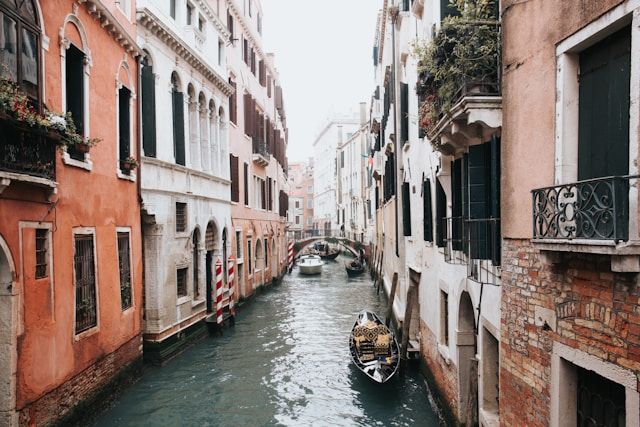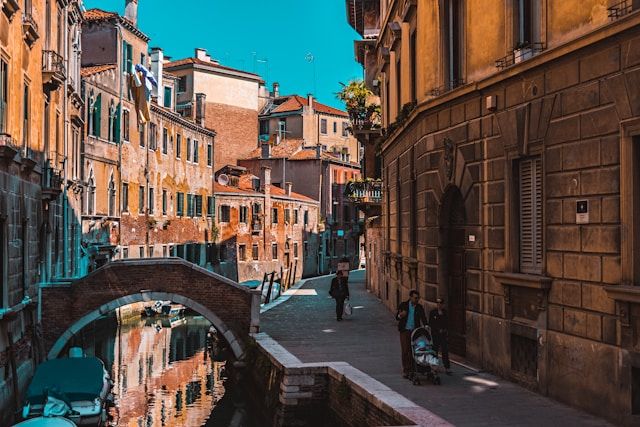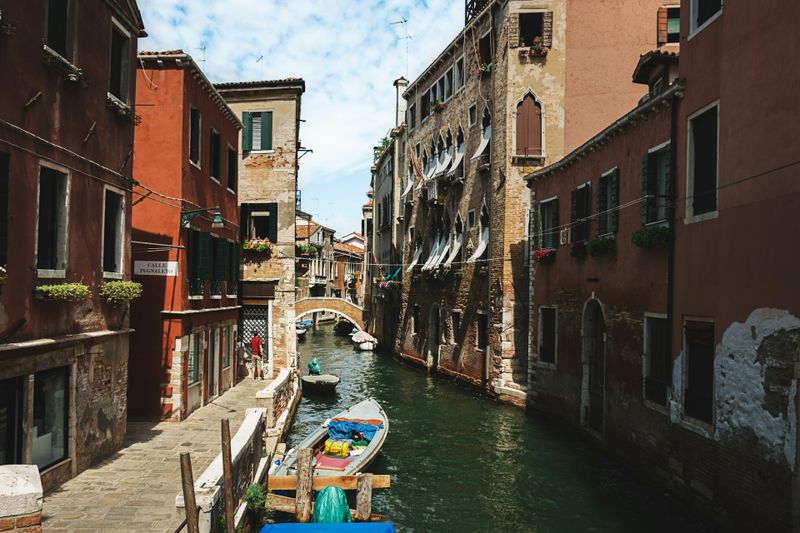The streets of Venice, known as "calli," are as unique as the city itself. Venice is a labyrinth of narrow passages, quaint squares, and winding canals that transport visitors back in time. What truly sets Venice apart, however, is the curious and often puzzling names of its streets.
From "Calle del Forno" to "Ruga Vecchia San Giovanni," each name carries with it a story, a piece of history, or a reference to an ancient trade or local legend.
In this article, we will explore why the streets of Venice have curious names, delving into the origins of these names and uncovering the secrets hidden within the city's toponymy.
Why the streets of Venice have curious names: The origins

Venice is a city like no other, and its street names are a reflection of its rich and diverse history. Unlike most cities, where street names are often chosen by municipal authorities or are the result of modern urban planning, the names of the streets in Venice have evolved over centuries.
These names often carry deep historical significance, and understanding them provides insight into the life and culture of ancient Venice.
To begin with, it is important to note that there is no single explanation for why the streets of Venice have such curious names. The origins of these names are varied, and they reflect the complex history of the city. Some street names are linked to the trades that were practiced there.
For example, "Calle del Pestrin" refers to the street of the milkman, "Calle del Pistor" to the street of the baker, and "Calle del Fruttarol" to the street of the fruit seller. These names hark back to a time when the city’s streets were organized around the daily lives of its inhabitants, with each trade or craft having its own designated area.
Other street names in Venice are associated with commercial activities. A prime example of this is the area known as the "Mercerie," where fabrics were sold. "Frezzerie" is another such name, referring to the street where arrows were manufactured, while "Calle Fiubera" was named for the craftsmen who made shoe buckles.
These names reflect the importance of commerce in the Venetian Republic, where trade was the lifeblood of the city.
In addition to trades and commerce, some of Venice's street names are rooted in local legends or historical events. For instance, "Calle della Madonna" may refer to a local shrine or a miraculous event associated with the Virgin Mary. These names often serve as reminders of the city’s rich cultural and religious heritage, as well as its deeply ingrained traditions.
Are there street names in Venice?

Yes, there are indeed street names in Venice, although they differ significantly from those in most other cities. In Venice, the term "calle" is used instead of "via" to denote streets. The term "calle" literally means "narrow street" in Venetian dialect, and it is used throughout the city to refer to the many narrow alleys that wind through its districts.
Additionally, other types of streets include "ruga," "salizada," and "rio terà." Each of these terms has a specific meaning, reflecting the unique characteristics of the Venetian streets. For example, a "ruga" is a street lined with shops, while a "salizada" refers to a paved street, indicating that it was one of the first streets to be paved in the city.
What is unique about the streets of Venice?
The streets of Venice are unique for several reasons, the most obvious being that they are often not streets at all. Venice is a city built on water, and its primary means of transportation is through its network of canals. However, when it comes to pedestrian paths, Venice offers a distinctive experience with its narrow alleys, hidden squares, and countless bridges.
One of the most intriguing aspects of Venetian streets is their irregular layout. Unlike the grid patterns common in modern cities, Venice’s streets were developed organically over centuries. As a result, they often twist and turn in unexpected ways, leading to dead ends or suddenly opening onto a bustling "campo" (square).
The streets are also incredibly narrow, with some being so narrow that they are known as the "narrowest calle" in the city. One of the narrowest streets in Venice is "Calle Varisco," which measures just 53 centimeters at its widest point.
The uniqueness of Venice’s streets is also reflected in their names, which are often descriptive of the geography, historical events, or activities that once took place there. For instance, "Calle del Forno" (Street of the Oven) likely refers to a bakery that once operated in the area, while "Campo Santa Margherita" is named after the church dedicated to Saint Margaret.
The names often provide clues to the city’s past, offering a glimpse into the everyday life of Venetians in ancient times.
Do the Canals in Venice have names?
Yes, the canals in Venice do have names, and just like the streets, these names often carry historical significance. The most famous canal in Venice is the "Grand Canal," which serves as the main waterway through the city, winding its way through Venice in a large reverse "S" shape. The Grand Canal is lined with magnificent buildings, many of which were constructed during the height of the Venetian Republic.
In addition to the Grand Canal, there are numerous smaller canals, known as "rii" (singular: rio), each with its own name. For example, "Rio Terà" refers to a canal that was once filled in to create a pedestrian street. "Riva del Carbon" and "Riva del Vin" are names of quays along the Grand Canal, each referring to the goods that were historically unloaded there: coal and wine, respectively.
The names of the canals, like those of the streets, often reflect the function or history of the area. "Rio della Giudecca" is named after the Giudecca Canal, which separates the main city from the island of Giudecca. The names provide a window into Venice’s rich maritime history and its reliance on water for transportation and trade.
What does "Via" mean in italian street names?
In Italy, the term "via" is the most common word used to denote a street. It simply means "way" or "street" in Italian and is used throughout the country. However, in Venice, the term "calle" is used instead of "via" due to the city’s unique topography and historical development.
The use of "calle" in Venice is a reflection of the city’s Venetian dialect, which differs from standard Italian. Other terms such as "ruga," "salizada," and "rio terà" are also used to describe different types of streets and pathways in Venice, each with its own specific meaning and historical context.
Why the streets of Venice have curious names: Exploring some notable venetian streets and squares
Now that we have explored why the streets of Venice have curious names, let’s take a closer look at some of the city’s most famous and historically significant streets and squares.
Calle del Forno – This street, whose name translates to "Street of the Oven," likely refers to a bakery that once operated here. It is a typical example of how Venetian street names often reflect the trades or businesses that were once located there.
Campo San Polo – This is one of the largest squares in Venice, second only to Piazza San Marco. It has a rich history and has been used for various purposes over the centuries, including as a marketplace and a site for public events.
Campo Santa Margherita – A lively square located in the Dorsoduro district, Campo Santa Margherita is named after the church of Santa Margherita. It is a popular gathering place for both locals and tourists, filled with cafés, restaurants, and markets.
Ruga Vecchia San Giovanni – This street is an example of a "ruga," a type of street lined with shops. The name "Vecchia" means "old," indicating that it was one of the older streets in the city, and "San Giovanni" refers to a nearby church.
Riva del Carbon – Located along the Grand Canal, this quay was historically used for unloading coal, which was a vital resource for the city. The name "Carbon" directly references this trade.
Calle della Madonna – This street name is likely associated with a religious shrine or a statue of the Madonna, a common feature in many Venetian streets. The presence of such names highlights the deep religious roots of Venice.
Riva del Vin – Another quay along the Grand Canal, Riva del Vin was historically associated with the unloading of wine. The name reflects Venice’s important role in the wine trade.
Strada Nova – This street is one of the few that can accommodate a larger number of people due to its relatively wide width. The name "Nova" means "new," indicating that it was a more recent addition to the city’s street network.
Why the streets of Venice have curious names: The fascinating world of venetian street names
In conclusion, the streets of Venice are much more than mere paths between buildings; they are a living testament to the city’s rich history and cultural heritage. The curious names of these streets, from Calle del Forno to Ruga Vecchia San Giovanni, tell the story of Venice’s past, its trades, its legends, and its people. Each name is a piece of a larger puzzle, revealing the layers of history that have shaped this unique city.
Understanding why the streets of Venice have curious names provides a deeper appreciation for the city and its unique character. Whether you are walking through Campo San Polo or crossing the Rialto Bridge, each step in Venice is a journey through history. The names of the streets, canals, and squares are a reminder of the city’s glorious past, its maritime empire, and its role as a cultural crossroads.
The Venetian Republic was a major maritime power during the Middle Ages and the Renaissance, and its influence is still evident in the city’s architecture, art, and street names. The Grand Canal, Piazza San Marco, and Riva degli Schiavoni are just a few examples of how the city’s streets and canals are intertwined with its history.
If you ever have the chance to visit Venice, take a moment to consider the names of the streets as you wander through the city. Each name is a clue, a story waiting to be discovered. From the narrowest calle to the grandest piazza, Venice’s streets are filled with history, culture, and mystery.
The final reflection: A walk through the streets of Venice
As we conclude our exploration of why the streets of Venice have curious names, it’s important to highlight some of the most iconic locations and terms associated with the city. Whether you are strolling along Calle del Forno, exploring Campo San Polo and Campo Santa Margherita, or marveling at the grandeur of the Venetian Republic in Piazza San Marco, you are walking through history.
From the bustling Grand Canal to the quiet corners of Calle della Madonna, the streets of Venice offer a unique experience that cannot be found anywhere else. The city’s ancient streets, such as Ruga Vecchia San Giovanni and the Venetian calli of the Sestiere di Santa Croce, are living museums, each telling the story of ancient Venice.
As you cross the Rialto Bridge and wander through the paved streets, you will encounter names like Rio Terà, Venetian streets, Riva del Carbon, and Riva del Vin. Each of these names is a reminder of Venice’s past, its trades, its commerce, and its people.
Whether you are in San Polo or Piazzale Roma, near the train station or the Doge's Palace, the streets in Venice are filled with history. Names like Ruga Rialto, Calle Amor dei Amici, Strada Nova, and Ponte dei Sospiri transport you to a different time.
Even the lesser-known streets, such as Calle Varisco, offer a glimpse into the city’s history. From Santa Croce to the Teatro La Fenice, from foreign rulers to famous people, Venice’s streets are a reflection of its diverse past.
So, as you walk through the streets of Venice, remember that each name is a part of the city’s rich tapestry. From the Giudecca Canal to Ca’ Pesaro, from the Ruga Rialto to the Riva del Vin, Venice’s streets are filled with history, culture, and stories waiting to be discovered. The next time you find yourself in this magical city, take the time to explore its venetian toponymy, and uncover the mysteries hidden within its streets, canals, and squares.

